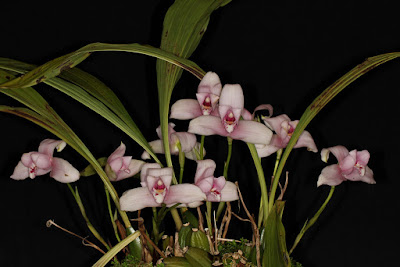Lycaste skinneri is found in Mexico, Guatemala, El Salvador and Honduras. It grows both epiphytic in trees and lithophyte on rocks in wet montane forests and pine-oak-liquidambar forests at an altitude of up to 2000 meters above sea level...
Lycaste skinneri also called as White Nun Orchid, Skinner's Lycaste, Lycaste alba, Lycaste albida, Lycaste amabilis, Lycaste jamesiana, Lycaste schoenbrunnensis, Lycaste skinneri f. virginalis, Lycaste skinneri subvar. alba, Lycaste skinneri var. alba, Lycaste skinneri var. albaviridis, Lycaste skinneri var. armeniaca, Lycaste skinneri var. cobanensis, Lycaste skinneri var. gloriosa, Lycaste skinneri var. labelloalba, Lycaste skinneri var. labelloflava, Lycaste skinneri var. reginae, Lycaste skinneri var. superba, Lycaste skinneri var. virginalis, Lycaste virginalis, Maxillaria skinneri, Maxillaria skinneri, Maxillaria virginalis, is a species of the genus Lycaste. This species was described by John Lindley in 1843.
IDENTIFY LYCASTE SKINNERI ORCHID PLANT
Lycaste skinneri is found in Mexico, Guatemala, El Salvador and Honduras. It grows both epiphytic in trees and lithophyte on rocks in wet montane forests and pine-oak-liquidambar forests at an altitude of up to 2000 meters above sea level.
It is a warm to cold growing, large sized, epiphytic or lithophytic orchid with ovoid, compressed, up to 8 cm long pseudobulbs carrying several, apical, deciduous, plicate, elliptic-lanceolate, acuminate, 30-50 cm long and 10-15 cm wide leaves, dropping in the autumn.
White Nun Orchid blooms in the winter and early spring from the erect inflorescence, with a few at once, 15 to 30 cm long, single flowered inflorescence with the peduncle being concealed by inflated sheathing bracts. The flowers are waxy, very intense smell, about 15 cm in diameter. Sepals long-lanceolate, from white to violet-pink. Petals are elliptical, broad, strongly arched forward, gently pink on top, and reddish-purple inside. The lip is triple, white or yellowish, covered with red-violet spots and veins, inside has a yellow stain. The pure white form of the flower with a small fraction of the yellow inside the lip is rare enough and has the name Lycaste skinneri var. alba.
LYCASTE SKINNERI ORCHID PLANT CARE AND CULTURE
Cultural information should only be used as a guide, and should be to be adapted to suit you. Your physical location; where you grow your plants, how much time you have to devote to their care, and many other factors, will need to be taken into account. Only then can you decide on the cultural methods that best suit you and your plants.
Light:
Lycaste skinneri loves the bright sun without access to direct sunlight, so during the hot midday sun on the windows of the southern orientation and the hot evening sun on the western windows, the orchid should be placed behind a curtain (for example, on a table near the window) or in the shade of other plants. Otherwise, the orchid can get sunburn.
Temperature:
This kind of orchid refers to the moderately cold temperature regime, and throughout the year the plants are recommended to contain under the following conditions: Summer temperature is not more than 28 ° C; Winter temperature is 14-20 ° C in the daytime and 10 ° C at night. For the successful cultivation at home, it is necessary that the night temperature of the contents always be at least 6 ° C (ideally 10 ° C) lower than the daytime temperature.
Humidity:
This kind of orchids loves high humidity and its index should not fall below 70%, in the morning hours 90-100%. Too dry air adversely affects the development of the plant and its growth is inhibited, and the flowers become pale and dry out.
Substrate, growing media and repotting:
Lycaste skinneri is usually grow in ordinary or clay pots. As a substrate, a mixture of bark of coniferous trees with charcoal, foam, expanded clay and beech leaves is best.
Watering:
During the period of new growth, this orchid needs frequent and abundant watering. Excess water during watering should flow freely out of the pot, as the stagnation of water both inside the pot and in its pan can very quickly lead to decay of the roots and the lower part of the plant. The substrate between the irrigations should dry relatively well, but do not dry completely.
In the hot summer period, daily spraying of the outer part of the plant is recommended, this will increase the humidity around the orchid and help it to survive the heat better.
Fertilizer:
During the new growth period, this type of orchid is fertilized once every 2-3 weeks in 1/2 or 1/4 of the fertilizer concentration indicated on the package. In addition to the usual root top dressing, it is also recommended to produce a foliar dressing, when a very much diluted fertilizer is sprayed on the outer part of the plant. It is best to feed the plant, alternating both these methods.
Rest period:
Since December, Lycaste skinneri are placed in the brightest place and are kept at a temperature of 14 to 20 ° C day and around 10 ° C at night. Watering should be coordinated at relatively lower temperatures and produced slightly more often than once every 2-3 weeks. The substrate must always be slightly moist, but not wet. This plant can bloom before and after this period. In early March, the rest period ends and the overall temperature of the content rises.















COMMENTS